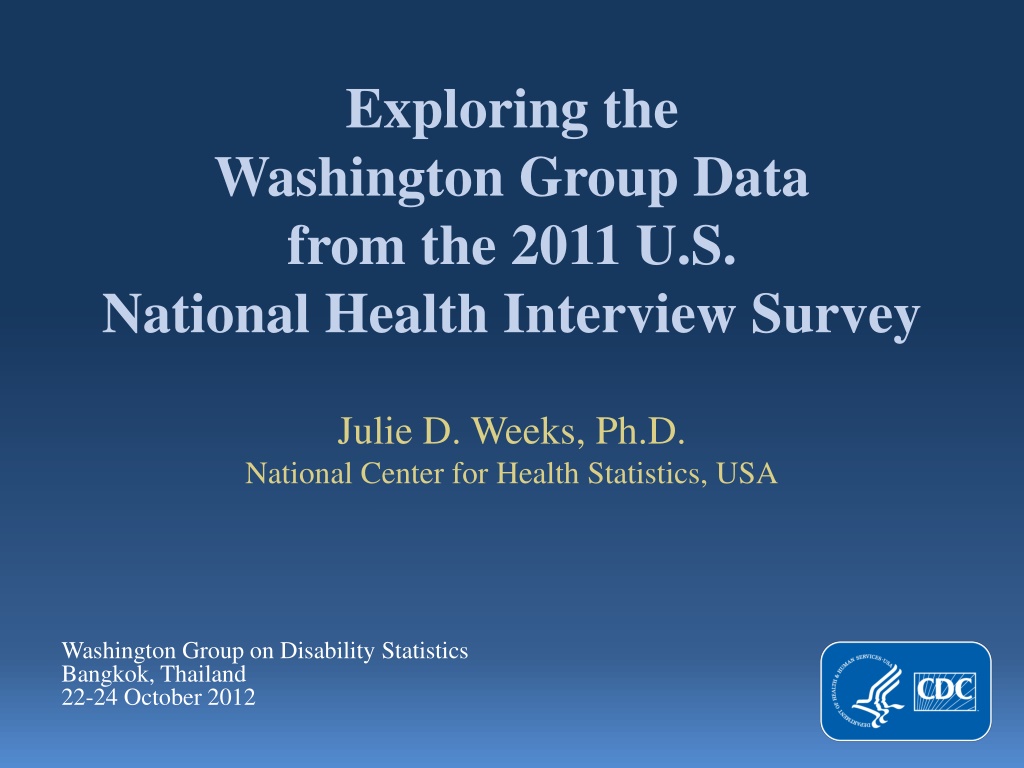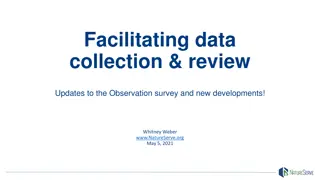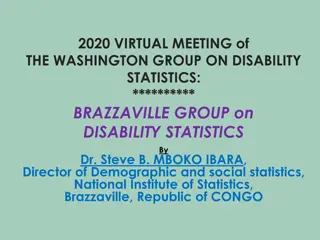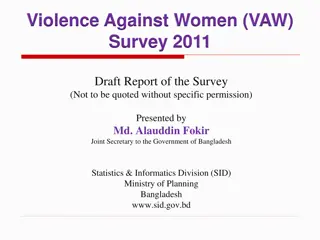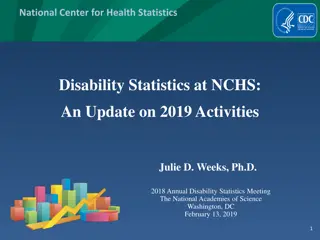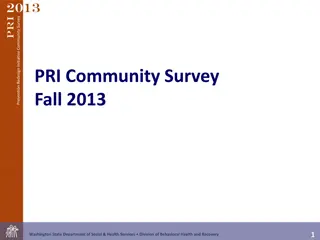Exploring Washington Group Data from 2011 NHIS Survey
In this presentation, Julie D. Weeks, Ph.D., explores Washington Group data from the 2011 U.S. National Health Interview Survey. The presentation covers an overview of NHIS survey characteristics, examination of disability prevalence using the WG-SS and a broad definition, coding choices, cut points for disability prevalence definitions, and suggestions for next steps. The NHIS is a key source of health information in the U.S., focusing on the civilian noninstitutionalized population since 1956. Survey characteristics include in-person and telephone follow-up interviews, annual cross-sectional estimates with a sample size of 35,000 households and 87,500 persons.
Download Presentation

Please find below an Image/Link to download the presentation.
The content on the website is provided AS IS for your information and personal use only. It may not be sold, licensed, or shared on other websites without obtaining consent from the author. Download presentation by click this link. If you encounter any issues during the download, it is possible that the publisher has removed the file from their server.
E N D
Presentation Transcript
Exploring the Washington Group Data from the 2011 U.S. National Health Interview Survey Julie D. Weeks, Ph.D. National Center for Health Statistics, USA Washington Group on Disability Statistics Bangkok, Thailand 22-24 October 2012
Purpose of Presentation The WG questions have been collected as part of the U.S. National Health Interview Survey since 2010. In this presentation: Overview of NHIS survey characteristics; Examine the WG-SS items by sociodemographics; Examine the overall prevalence of disability using the WG-SS and a broad definition of disability; Examine the WG-ES items by sociodemographics; Discussion of coding choices in all domains; Discuss the cut points for definitions of disability prevalence; Make suggestions for next steps.
The National Health Interview Survey (NHIS) The principal source of information on the health of the civilian noninstitutionalized population of the United States. Since 1956, the NHIS has provided statistical information on the amount, distribution, and effects of illness and disability in the U.S. and the health services received for such conditions. Comprised of Core questions asked each year of the Household, Family, a Sample Adult and a Sample Child, and Supplement questions that address special topics and change periodically.
NHIS Characteristics Survey context: Health and health care survey Survey scope: Civilian, noninstitutionalized population Survey mode: In-person, some telephone followup Trained U.S. Census interviews Computer-assisted personal interviewing Periodicity: Annual, repeated cross-sectional estimates Sample Size: Each year completed interviews with 35,000 households 87,500 persons
NHIS Interview Protocol Household respondent provides basic socio- demographic information on all members of household For each family within a household knowledgeable adult 18 or older responds for him/herself and all other family members sample adult 18 or older and sample child under age 18 randomly selected for more extensive set of questions
NHIS Structure: Basic Module Family Core General info on all family members Household and family data Allows proxy respondents Fielded each year Demographic and general health data Sample Adult Core Self-response only Fielded each year Health condition, risk behavior, and health behavior data Sample Child Core Knowledgeable adult responds for child Fielded each year
Examples of Previous and Current NHIS Supplements Arthritis (2002, 2003, 2006, 2009) Asthma (2002, 2008, 2013) Balance/Dizziness (2008) Complementary and Alternative Medicine (2002, 2007, 2012) Cancer (2000,2005, 2010) Diabetes (2003, 2007) Disability (2002, 2008- present) (WG 2010-present) Epilepsy (2010, 2013) Food Security (2011- present) Immunization (2008-present) Hearing (2002, 2007, 2008) Heart Disease (2001, 2008) Mental Health (2001-2010) Occupational Health (2010) Oral Health (2008) Vision (2002, 2008)
2011 NHIS-WG Data Characteristics Analytic Sample: 16,540 adults, ages 18 years and over Male: 45% Female: 56% 18-44 years: 46% 45-64 years: 34% 65+: 21% Less than high school: 17% High school or equiv.: 56% College: 27% Below 100% poverty: 18% 100% - < 200% poverty: 21% 200% or above poverty: 61%
Short Set WG Items: Methods Tables on pages 1-12 contain provide NHIS data from the following: Short Set items, individually, by sociodemographics: Vision Hearing Mobility Communication Cognition Upper Body All response categories are shown: no diff, some diff, a lot of diff, cannot do at all. U.S. population 18 years and over
Short Set WG Individual Items: Impressions Results of the individual Short Set questions show some interesting results: Women > Men: vision, mobility, cognition. Men > Women: hearing, communication Age relationship as expected: severity worsens with age However, even though the older pop have greater proportion of difficulty, the largest population with difficulty is the 18-64 population. Education, poverty status and marital status also as expected. Some category captures largest pop with difficulty. Is this a problem?
Definitions for Prevalence of Disability Four measures have been proposed by the WG: 1. a broad measure that includes everyone with at least one domain coded as some difficulty, a lot of difficulty, or unable to do it 2. a measure that excludes the mildest degrees of difficulty and includes everyone with at least one domain coded as a lot of difficulty, or unable to do it 3. a narrow measure that focuses on the most severe levels of difficulty and includes everyone with at least one domain coded as unable to do it at all 4. a measure that is slightly more restrictive than #1 and includes everyone with at least one domain that is coded as a lot of difficulty or cannot do it at all or at least some difficulty in two domains.
Short Set WG Summary Measure: Impressions Page 13 shows the prevalence of disability in the 18+ population, combining the six Short Set questions. The overall rate of disability, using the broad definition, is 33.4%. This rate is consistent with another measure of difficulty used in the U.S. indicating Basic Actions difficulty. Difficulty walking or climbing steps contributes the greatest to the overall rate. Followed by cognition, hearing and vision. The some difficulty category is much larger than others. Page 15 shows disability by sociodemographic characteristics.
Short Set WG Summary Measure: Varying Cut-Off Points What would the overall rate of disability be, as measured by the Short Set, using the other recommended definitions? 1. at least one domain is scored some difficulty = 33.4% 2. at least one domain is scored a lot of difficulty = 8.9% 3. at least one domain is scored unable to do it at all = 2.4% 4. at least one domain is scored a) as a lot of difficulty or unable to do it or b) at least some difficulty is scored in two domains = 17.6%
Extended Set WG Items: Methods Tables on pages 17-30 contain provide NHIS data from the following: Extended Set items, individually, by sociodemographics: Hearing: quiet room, noisy room, comparison Mobility: 100 yards, 1/3 mile, walking stairs, comparison Upper Body: lifting, grasping, comparison Anxiety Depression Pain Fatigue All response categories are shown: no diff, some diff, a lot of diff, cannot do at all. U.S. population 18 years and over
Extended Set WG Items: Coding of Hearing For the extended set, the hearing variable combines difficulty hearing, difficulty hearing in a quiet room and difficulty hearing in a noisier room: 1. Any difficulty hearing yes = 11.4% 2. Any difficulty hearing in a quiet room or a noisier room, AND, no difficulty to #1 = 16.7% 3. Any difficulty hearing extended set = 28.2% In this way, we add the Short Set measure and the Extended set questions on hearing to form the Extended Hearing measure. Page 19
Extended Set WG Items: Coding of Mobility For the extended set, the mobility variable combines difficulty walking or climbing stairs, difficulty walking 100 yards, difficulty walking 1/3 mile, difficulty walking stairs, and use of wheelchair or scooter: 1. Any difficulty walking or climbing stairs yes = 16.3% 2. Any difficulty walking 100 yards or 1/3 mile or walking up and down stairs, OR, uses a wheelchair or scooter, AND no difficulty to #1 = 7.3% 3. Any difficulty with mobility extended set = 23.6% Page 23
Extended Set WG Items: Coding of Upper Body For the extended set, the upper body variable combines difficulty with self care, raising a 2L bottle, and using hands or fingers to grasp: 1. Any difficulty with self care = 3.9% 2. Any difficulty raising a 2L bottle from waist to eye level or using hands or fingers to grasp, AND, no difficulty to self care = 6.9% 3. Any difficulty with upper body extended set = 10.8% Page 26
Extended Set WG Summary Measure: Impressions Page 31 shows the prevalence of disability in the 18+ population, combining the questions in the 10 domains. The overall rate of disability, using the broad definition, is 61.1%. This rate is almost double the rate derived from the Short Set. Adding a) follow-up questions in the hearing and mobility domains and b) adding the domains anxiety, depression, pain and fatigue greatly increase the prevalence rate. Further work to create measures in the additional extended domains may or may not further increase this rate. Page 32 shows disability by sociodemographic characteristics.
Extended Set Analyses: Next Steps Understanding how the WG Extended Set is operating and who we are capturing requires much more analysis. For hearing, is quiet and noisy room operating the way we want? Are we constructing the mobility and upper body extended measure correctly? For the domains of anxiety, depression, pain and fatigue, how do we construct summary measures across the questions of frequency, intensity and duration? Do questions about equipment tell us anything about functioning? Are the medication questions adding to our understanding?
Extended Set Analyses: Next Steps Understanding how the WG Extended Set is operating and who we are capturing requires much more analysis. What cut points in level of difficulty are useful for what purposes? Is the purpose of the Extended Set to add more people to the prevalence rate or understand greater detail within a domain of functioning? Examine disparities among those at risk, including participation (social inclusion) and quality of life.
